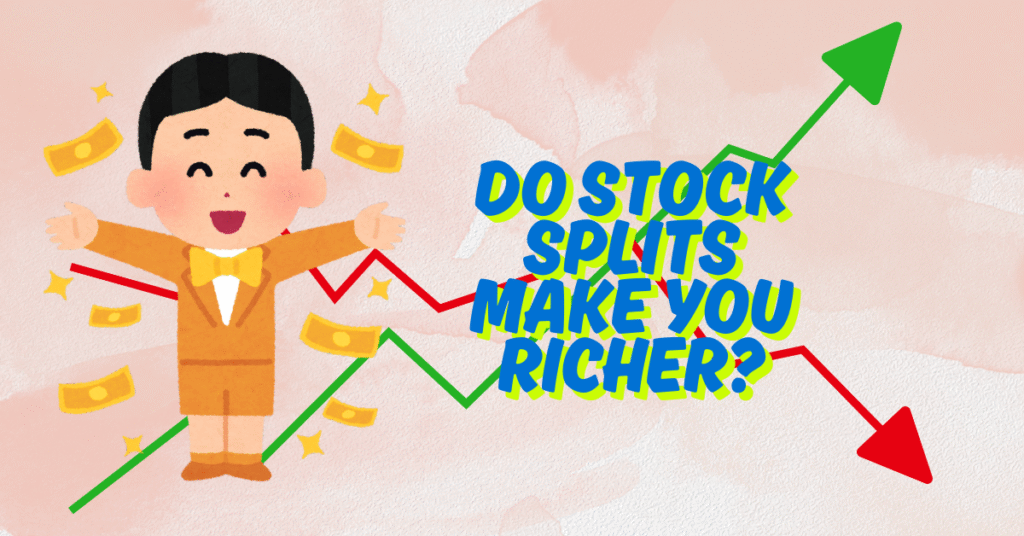Introduction:
Stock splits are a common phenomenon in the world of investing, but many investors often wonder whether they truly benefit from such moves. While stock splits can be exciting and make shares more affordable, they don’t necessarily make investors richer. Let’s take a closer look at what a stock split is, how it affects the value of shares, and what it means for investors, especially those looking for long-term gains and dividend income.
How Does a Stock Split Affect the Value of Your Shares?
A stock split is a corporate action that increases the number of shares in circulation while keeping the overall value of the company the same. This means that if you owned 10 shares priced at $100 before a 2-for-1 stock split, you’d end up with 20 shares priced at $50 each. The total value of your investment remains unchanged, so a stock split doesn’t increase or decrease the value of your holdings. Essentially, the market capitalization of the company stays the same, but the price per share is adjusted to make it more affordable for a wider range of investors.
However, stock splits often create a sense of optimism and can lead to increased trading activity. While the value of your shares doesn’t immediately increase, stock splits may be seen as a sign that the company is growing or that its stock is becoming more accessible to smaller investors.
How Often Do Companies Perform Stock Splits?
Stock splits are relatively infrequent events and are typically done by companies that have seen a significant increase in share prices over time. The most common reason for a stock split is to lower the share price to a more affordable level for smaller investors, while still maintaining the company’s market value.
In recent years, many companies with strong growth—such as Apple, Tesla, and Amazon—have performed stock splits to accommodate demand. However, these events aren’t as common as other corporate actions, like dividends or share buybacks. Historically, stock splits have become less frequent as companies now prefer other methods of handling share price increases.
How Do Stock Splits Impact Long-Term Investors?
For long-term investors, stock splits generally don’t have a significant impact on the total value of their portfolio. However, the psychological effect can be powerful. Investors may feel as if they are getting more shares at a lower price, which can trigger renewed interest in a company’s stock. If the company continues to grow, stock splits may be seen as an indication of financial health and ongoing success.
For those who are committed to long-term investing strategies, a stock split might present an opportunity to increase the number of shares they own without having to spend more money. However, it’s important for long-term investors to remember that stock splits alone do not increase wealth—continued company growth and reinvested dividends are key drivers of long-term financial success.
How Do You Build a Dividend Income Portfolio?
Building a dividend income portfolio involves selecting dividend-paying stocks that regularly pay dividends, which can then be reinvested or used as a source of steady income. A well-diversified dividend income portfolio should contain stocks from various sectors, providing both stability and growth potential. Here are some key steps to building a successful dividend portfolio:
-
Research Reliable Dividend Payers: Look for companies with a strong history of paying consistent and growing dividends.
-
Diversify Your Holdings: Invest across different industries and sectors to reduce risk.
-
Reinvest Dividends: Reinvesting your dividends can lead to compounding growth over time.
-
Consider Dividend Yield and Payout Ratio: A high dividend yield is attractive, but make sure the company’s payout ratio is sustainable to ensure long-term stability.
-
Review Regularly: Monitor your portfolio to ensure it’s balanced and aligned with your income goals.
Building a solid dividend income portfolio takes time and careful planning. The key is to focus on companies with strong fundamentals that consistently increase dividends over time. Investing in dividend-paying stocks can provide long-term returns through reinvestment and compounding.
Bottom Line
While stock splits don’t directly make you richer, they can have psychological effects and increase accessibility to stocks. For long-term investors, the real wealth-building potential comes from a well-constructed portfolio, strong company fundamentals, and reinvestment strategies like dividend income. Whether or not a stock split happens, investing in quality companies with solid growth prospects and a reliable dividend payout strategy will likely be the key to increasing wealth over time.
FAQs
Q. Will a stock split make me richer?
- No, stock splits don’t increase the overall value of your investment. They simply adjust the number of shares you own and the price per share.
Q. What happens to my shares during a stock split?
- Your shares will increase in number, but their price will decrease proportionally. Your total investment remains the same.
Q. Should I buy a stock before or after a split?
- There’s no clear advantage to buying before or after a split. The stock price will likely adjust after the split, and the long-term growth of the company is a more important factor to consider.
Q. How do stock splits impact dividends?
- After a stock split, the dividend payout is typically adjusted to reflect the new share count. The total dividend you receive will remain similar, but each share will pay a lower dividend.
Q. Can a stock split lead to long-term gains?
- A stock split alone doesn’t guarantee long-term gains. Long-term success depends on the company’s financial health, growth, and other factors such as the broader market conditions.

Owner of Paisewaise
I’m a friendly finance expert who helps people manage money wisely. I explain budgeting, earning, and investing in a clear, easy-to-understand way.

